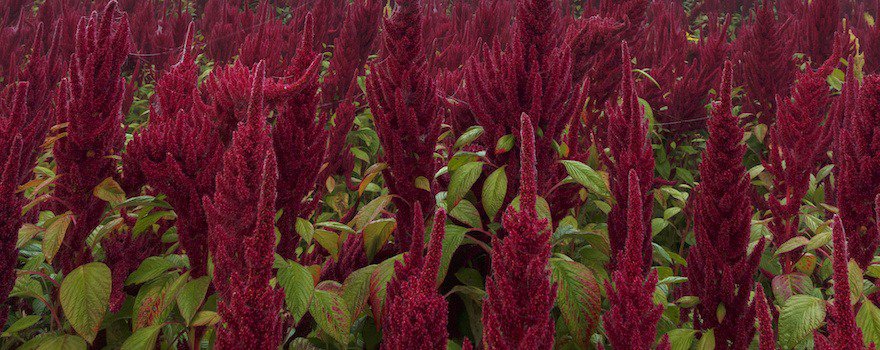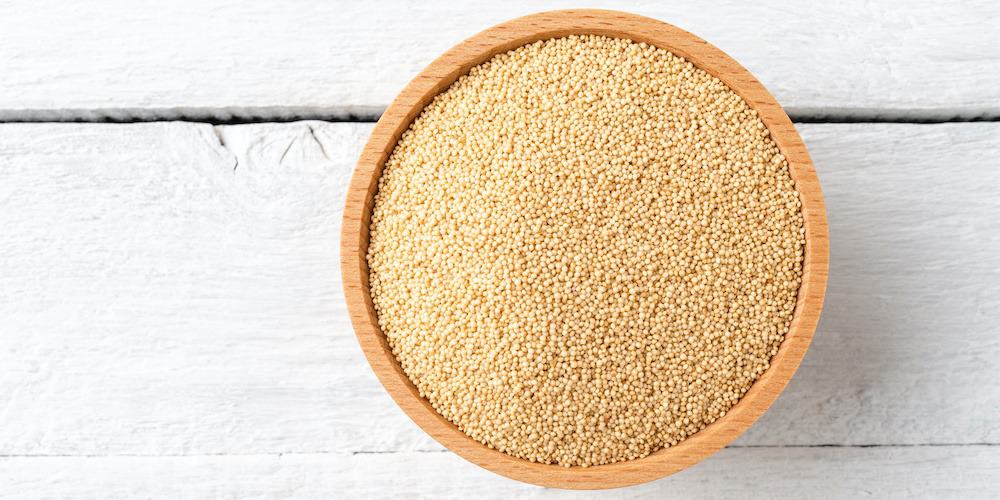BENEFITS OF AMARANTH
✓ Source of protein
✓ Reduces cholesterol levels
✓ Source of antioxidants
✓ Anti-inflammatory
✓ Helps with weight loss
What is amaranth?
Amaranth (Amaranthus) is a plant belonging to the Amaranthaceae family that includes more than 800 different species. Among the most cultivated and consumed are white amaranth (Amaranthus albus), foxtail amaranth (Amaranthus caudatus) and blite amaranth (Amaranthus blitum). All are native to the temperate and tropical regions of Central America.
Like buckwheat, it is a pseudo-cereal : it is not a cereal (it is not part of the grasses) but its seeds are consumed as such. The leaves of the plant are also edible.
In the time of pre-Columbian civilizations, it was part of the staple diet of the Incas in Peru and of the Maya and later the Aztecs in Mexico.
The earliest evidence of its cultivation dates back 5,000 to 7,000 years. Prepared in various ways (beverages, sauces, flatbreads…), it was prized for its nutritional qualities.
Long forgotten, it reappeared on our plates in the 1970s. This pseudo-cereal highly nutritious is noteworthy for many reasons. An excellent source of plant-based proteins, it also helps reduce cholesterol levels, protect the body from free radicals, and relieve inflammation. Finally, its fiber content helps with weight loss.
Nutritional composition
- Acides aminés
- Vitamines : A, B2, B3, B5, B6, B9, C, E, K
- Minéraux et oligo-éléments : fer, calcium, magnésium, manganèse, phosphore, potassium, cuivre, zinc, sélénium
- Protéines
- Glucides
- Fibres
- Actifs antioxydants : acide gallique, acide p-hydroxybenzoïque, acide vanillique, squalène
- Acides gras : oméga-3, oméga-6

The benefits of amaranth
🌿 Source of protein
Amaranth seeds are an excellent source of plant-based proteins. Thus, 100 g of seeds contain about 14 g of protein , which is more than most legumes or dried beans. Therefore, the seeds are useful for vegetarians or vegans to make up for the lack of animal protein in their diet.
All the more so because these proteins are complete: like those of buckwheat and quinoa, they contain all the essential amino acids.
This review from the University of Natural Resources and Life Sciences in Vienna (Austria) demonstrates the nutritional value of amaranth.
🍳 Reduces cholesterol levels
Amaranth has hypocholesterolemic properties: it lowers total cholesterol and LDL cholesterol (or ‘bad cholesterol’). At the same time, it raises HDL cholesterol (or ‘good cholesterol’).
This action appears to be due to tocotrienol, a form of vitamin E with beneficial effects on cholesterol metabolism, and to squalene, an antioxidant acid involved in the regulation of cholesterol levels.
This study by the pharmaceutical company Cytochroma Inc. (Canada), conducted on hamsters, shows how amaranth oil reduces cholesterol levels.
🥝 Source of antioxidants
Amaranth contains powerful antioxidant compounds. It notably contains phenolic acids such as gallic acid, p-hydroxybenzoic acid and vanillic acid. They all effectively combat free radicals and prevent the damage they cause to cells and organs such as the liver.
This antioxidant action protects the body against many diseases related to the harmful action of free radicals: cardiovascular diseases, cancers, neurodegenerative diseases…
This study by the National University of San Luis (Argentina), conducted on rats, shows the antioxidant activity of amaranth seeds.
🔥 Anti-inflammatory
The consumption of amaranth can also have an effect on reducing inflammation. The plant has proven particularly beneficial in cases of chronic inflammation during allergies or autoimmune diseases. To do this, it prevents the activation of the NF-κB protein, which is involved in the body’s inflammatory response. In addition, it inhibits inflammation induced by lipopolysaccharide (LPS), which promotes the release of pro-inflammatory cytokines.
This study from the University of Illinois (United States), conducted on human and mouse macrophages, explains the mechanism of action of amaranth against inflammation.
🏃🏻♂️ Helps with weight loss
In addition to proteins, amaranth also contains a significant amount of dietary fiber: about 5 g per 100 g. By swelling and forming a viscous gel in the stomach, it increases the feeling of fullness and acts as a natural appetite suppressant. It can therefore be a valuable aid in limiting snacking during the day and supporting weight loss.
This study from the Defence Food Research Laboratory (India), conducted on rats, shows how consuming amaranth promotes satiety and contributes to weight loss.

How to consume amaranth?
Amaranth seeds
Cookable amaranth seeds with a mild nutty flavor are available commercially. Simply combine 1 part seeds with 2 parts water and cook for 15-20 minutes.
Allow them to swell and prepare like tabbouleh. Cooked seeds are also ideal for hot cereals and porridges, vegetarian patties, soups… You can add them raw to muesli or pop them like popcorn to make puffed amaranth seeds.

Amaranth leaves
Amaranth leaves are eaten like spinach and have a very similar flavor. They are served as a side with meat, fish, vegetables, gratins… They can also be used to make tarts and soups.
Amaranth flour
Amaranth flour comes from ground seeds and joins the list of gluten-free flours. It is therefore ideal for people with celiac disease, in combination with other gluten-free flours such as buckwheat flour, lupin, rice or carob.
You can use it for making breads, cakes, cookies, crêpes… at a proportion of one-third of the mixture. The flour has the advantage of adding softness to recipes.
Consume sustainably: favor organic and fair-trade amaranth
✓ Amaranth is mainly cultivated in Latin America: Argentina, Peru, Bolivia, Mexico… In response to growing demand, its cultivation has gradually spread to Europe and parts of North America. But it remains still not widely cultivated in France. Even though our climatic conditions are favorable for its cultivation, it yields less than conventional cereals and suffers from its reputation as a ‘weed’.
✓ If you want to discover this pseudo-cereal, we recommend choosing seeds from organic farming and, if possible, from fair-trade supply chains. This way you will support the work of producers and small-scale family farming.
Dosage
You can consume between 60 and 80 g of amaranth per day (seeds or leaves).
Contraindications and side effects
Consumption of amaranth presents certain contraindications :
- Parce que ses feuilles contiennent de l’acide oxalique (responsable de calculs rénaux), elles ne doivent pas être consommées en excès
- Les personnes souffrant de pancréatite, de cholécystite, de calculs biliaires et d’urolithiase doivent éviter d’en consommer
- L’amarante est déconseillée aux personnes allergiques au blé en raison d’une possible allergie croisée
Excessive consumption may cause certain side effects :
- Nausées
- Vomissements
- Vertiges
- Réaction allergique
If you experience side effects, stop consuming it and consult a doctor.
History, cultivation, and market of amaranth
For several years, some species such as Palmer amaranth (Amaranthus palmeri) have been giving herbicide manufacturers a hard time. Indeed, they can adapt to them and even grow in treated fields thanks to their remarkable ability to reproduce.
An amaranth plant can produce and disperse up to 12,000 seeds per year! Today, it is widely studied for its resistance to herbicides such as glyphosate.
Sources and scientific studies
Narpinder Singh, Prabhjeet Singh, 2011. Amaranth: Potential Source for Flour Enrichment.
Stefano D’Amico, Regine Schoenlechner, 2017. Amaranth: Its Unique Nutritional and Health-Promoting Attributes.
Alvin Berger, Gérard Gremaud, Marcel Baumgartner, Dietrich Rein, Irina Monnard, Elena Kratky, Wolfgang Geiger, Joseph Burri, Fabiola Dionisi, Martin Allan, Pierre Lambelet, 2003. Cholesterol-lowering properties of amaranth grain and oil in hamsters.
Alvaro Montoya-Rodríguez, Elvira González de Mejía, Vermont P Dia, Cuauhtémoc Reyes-Moreno, Jorge Milán-Carrillo, 2014. Extrusion improved the anti-inflammatory effect of amaranth (Amaranthus hypochondriacus) hydrolysates in LPS-induced human THP-1 macrophage-like and mouse RAW 264.7 macrophages by preventing activation of NF-κB signaling.
M V Mithila, Farhath Khanum, 2015. Effectual comparison of quinoa and amaranth supplemented diets in controlling appetite; a biochemical study in rats.
Jose Alfredo Dominguez-Valenzuela, Javid Gherekhloob, Pablo Tomás Fernández-Moreno, Hugo Enrique Cruz-Hipolito, Ricardo Alcántara-de la Cruz, Eduardo Sánchez-González, Rafael De Prado, 2017. First confirmation and characterization of target and non-target site resistance to glyphosate in Palmer amaranth (Amaranthus palmeri) from Mexico



